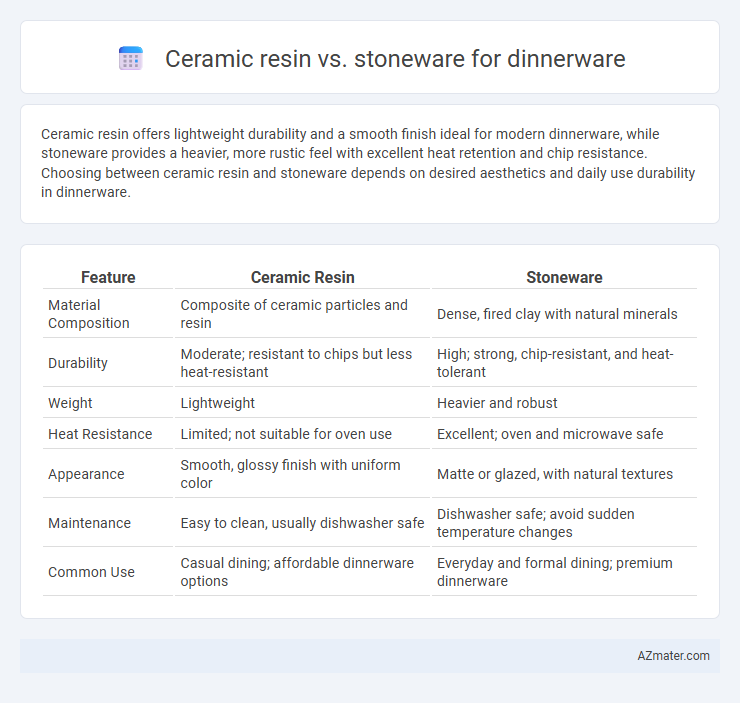Ceramic resin offers lightweight durability and a smooth finish ideal for modern dinnerware, while stoneware provides a heavier, more rustic feel with excellent heat retention and chip resistance. Choosing between ceramic resin and stoneware depends on desired aesthetics and daily use durability in dinnerware.
Table of Comparison
| Feature | Ceramic Resin | Stoneware |
|---|---|---|
| Material Composition | Composite of ceramic particles and resin | Dense, fired clay with natural minerals |
| Durability | Moderate; resistant to chips but less heat-resistant | High; strong, chip-resistant, and heat-tolerant |
| Weight | Lightweight | Heavier and robust |
| Heat Resistance | Limited; not suitable for oven use | Excellent; oven and microwave safe |
| Appearance | Smooth, glossy finish with uniform color | Matte or glazed, with natural textures |
| Maintenance | Easy to clean, usually dishwasher safe | Dishwasher safe; avoid sudden temperature changes |
| Common Use | Casual dining; affordable dinnerware options | Everyday and formal dining; premium dinnerware |
Introduction to Ceramic Resin and Stoneware
Ceramic resin dinnerware combines natural minerals with synthetic resins, offering lightweight, durable, and chip-resistant properties ideal for everyday use. Stoneware is a dense, non-porous ceramic fired at high temperatures, known for its strength, heat retention, and rustic aesthetic. Both materials provide versatile options, with ceramic resin excelling in impact resistance and stoneware favored for traditional, oven-safe dinnerware.
Material Composition and Properties
Ceramic resin dinnerware is composed of a blend of natural clay and synthetic resins, resulting in lighter, more flexible, and chip-resistant pieces compared to traditional stoneware, which is made from dense, high-fire clay known for durability and heat retention. Stoneware typically offers superior resistance to thermal shock and a rustic, earthy aesthetic due to its vitrified, non-porous surface, while ceramic resin provides enhanced stain resistance and varied design possibilities with smoother finishes. Both materials excel in microwave and dishwasher safety, but stoneware's robustness makes it ideal for heavy-use settings, whereas ceramic resin suits those seeking modern, lightweight alternatives.
Aesthetic Differences: Appearance and Finish
Ceramic resin dinnerware features a smooth, glossy finish with vibrant colors and intricate patterns, offering a sleek and modern aesthetic. Stoneware presents a more rustic, earthy look with matte or satin finishes that highlight natural textures and subtle color variations. The choice between ceramic resin and stoneware directly impacts the visual appeal, catering to contemporary minimalist designs or traditional, handcrafted styles.
Durability and Longevity
Ceramic resin dinnerware offers impressive durability with high resistance to chipping and cracking, making it ideal for everyday use. Stoneware is known for its robust, dense composition that withstands heavy impact and thermal shock, ensuring long-lasting performance. Both materials maintain their structural integrity over time, but stoneware typically excels in longevity due to its thicker, more resilient nature.
Weight and Handling Comfort
Ceramic resin dinnerware offers a lightweight alternative to traditional stoneware, making it easier to handle and less likely to cause fatigue during use. Stoneware, although heavier and sturdier, provides a substantial feel but may be cumbersome for daily, prolonged handling or for individuals with limited strength. The choice between ceramic resin and stoneware hinges on prioritizing ease of handling and weight versus durability and heft.
Heat and Scratch Resistance
Ceramic resin dinnerware typically offers moderate heat resistance, suitable for everyday use, but it may be more prone to scratching compared to stoneware. Stoneware is fired at higher temperatures, resulting in superior heat retention and enhanced durability, making it highly resistant to scratches and chips. This combination of heat and scratch resistance makes stoneware an ideal choice for long-lasting, resilient dinnerware.
Safety and Food Compatibility
Ceramic resin dinnerware is often non-porous and resistant to chipping, making it a safe choice for food contact without the risk of leaching harmful chemicals. Stoneware is naturally dense and fired at high temperatures, ensuring durability and a non-reactive surface that prevents food absorption and bacteria growth. Both materials meet FDA standards for food safety, but ceramic resin typically offers enhanced resistance to thermal shock and chemical corrosion.
Ease of Cleaning and Maintenance
Ceramic resin dinnerware offers non-porous surfaces that resist stains and require minimal effort for cleaning, making it highly practical for everyday use. Stoneware, while durable and chip-resistant, has a slightly porous finish that can absorb stains if not properly sealed, necessitating more careful maintenance. Both materials are dishwasher safe, but ceramic resin's smooth texture simplifies cleanup and reduces the need for harsh scrubbing.
Price Comparison and Value for Money
Ceramic resin dinnerware typically offers a more affordable price point compared to stoneware, making it a budget-friendly option for everyday use. Stoneware, while often priced higher, provides greater durability and chip resistance, contributing to enhanced value for money over the long term. Evaluating cost alongside longevity and aesthetic appeal helps determine the best investment for individual dining needs.
Choosing the Right Material for Your Dinnerware
Ceramic resin dinnerware offers durability and lightweight convenience, making it ideal for everyday use and outdoor dining, while stoneware provides a denser, more robust option with excellent heat retention and a rustic aesthetic favored for formal settings. Stoneware's natural clay composition ensures resistance to chipping and retains heat longer, enhancing food presentation and experience, whereas ceramic resin blends synthetic resins with ceramics, increasing impact resistance and ease of maintenance. When choosing dinnerware, consider factors like frequency of use, desired appearance, heat retention needs, and dishwasher safety to select the material that best fits your lifestyle and dining preferences.

Infographic: Ceramic resin vs Stoneware for Dinnerware
 azmater.com
azmater.com